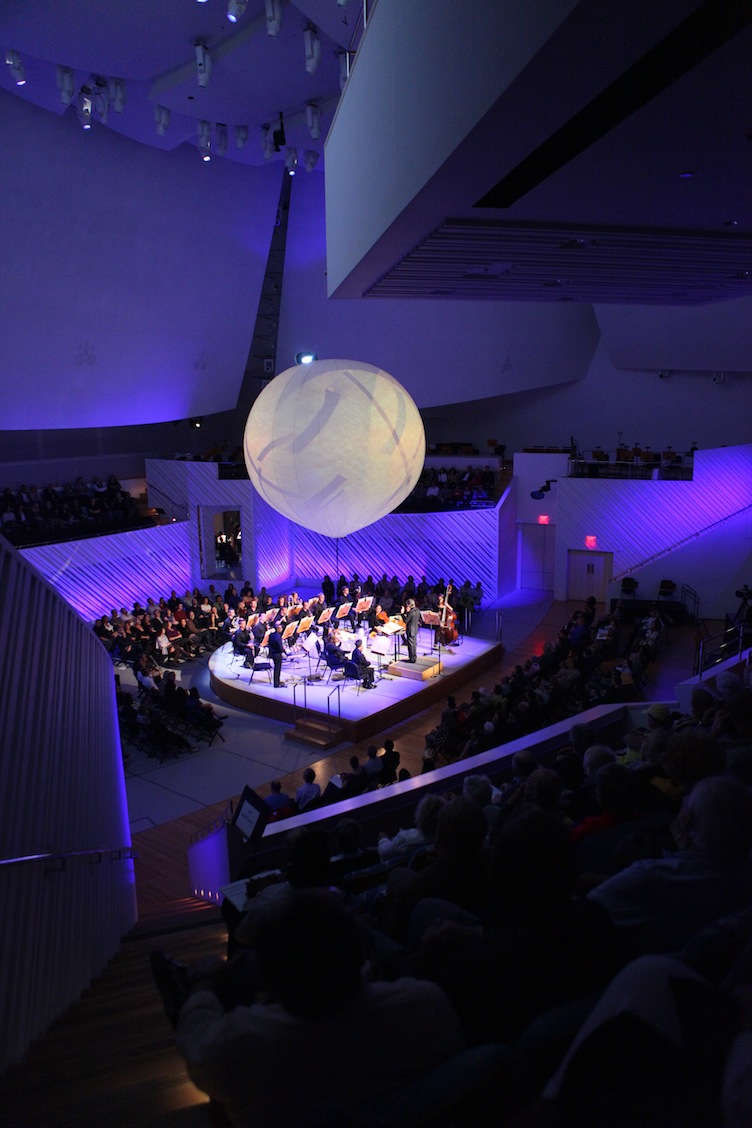Cage Festival ends exuberantly with lovable anarchy and news of a Grammy win

Michael Tilson Thomas conducts the New World Symphony in John Cage’s “Dance 4/Orchestras” at New World Center in Miami Beach. Photo: Rui Dias-Aidos
The final concert Sunday evening of the New World Symphony’s John Cage Centennial Celebration concentrated on scores from the 1970’s and 80’s.
But the music was initially upstaged by the announcement that New World’s artistic director Michael Tilson Thomas had just won his twelfth Grammy Award for a recording of works by John Adams. The South Beach audience greeted Tilson Thomas’s subsequent entrance with the kind of yelps and cheers usually reserved for rock stars and that energy was contagious throughout the three-hour concert.
Cage’s Dance 4/Orchestras (1982) is an early example of repetitive minimalism. Four instrumental groups occupied the backstage area and lower and upper lobbies of the New World Center in addition to the main stage with a large helium balloon suspended over the principal ensemble.
Lacking the sensual orchestral palette of a Phillip Glass or Steve Reich, Cage’s thirty minute, trance-like soundscape requires the musicians to play at extremes of volume from near inaudibility to blasts of surround sound, enlivened by distant whistles and harp glissandos. Videos of Cage’s artwork projected on the balloon and wall space complemented the audio mix. The often soft instrumental timbres and figurations produced luminous waves of sound, the distant instrumental cells enhancing the aura of Zen mysticism. Robert Blundell, Daniel Stewart and Michael Linville led the subsidiary ensembles, assisting Tilson Thomas in bringing a sense of precision and order to Cage’s unique audio collage.
The Etudes Australes (1974-75) are the twentieth-century piano equivalent of Paganini’s caprices, short pieces so difficult that they challenge the very extremes of the instrument and the performer’s technique. Each hand is required to play notes of the keyboard’s entire range, at times holding down one note with one hand while the other plays over and around it, making the wildest hand crossings in the scores of Bartok and Prokofiev seem like child’s play. The minute tinkles, cluster chords and sudden crashes of sound are more than mere pianistic exercises. There is a quirky wit and tensile beauty in Cage’s vignettes, the Etude No. 5 even breaks the composer’s artistic mantra and bursts forth into a sly melodic pattern.
Marc-Andre Hamelin has specialized in playing knuckle-busting, technically impossible scores that few other artists dare touch, including such rarities as Busoni’s massive Piano Concerto and Kaikhosru Sorabji’s four hour Opus Clavicembalisticum. With the requisite speed and dexterity, Hamelin was attentive to the most minute modulations of volume and timbre as well as the adventurous spirit necessary to bring Cage’s unique ruminations to life. Hamelin’s brilliant performance was a mini tour de force, and let’s hope that he is invited back to Miami soon to explore more of his unconventional repertoire.
Renga (1975-76) was an appropriate conclusion to this celebration of one of America’s true creative free spirits. Cage loved to create musical circuses, fusing disparate elements of art, music and dance. By grafting the rain forest sounds of Renga with a collage of Cage scores, videos of the eras’ popular culture, Cage’s art work and famous Lecture on Nothing, and a performance of Merce Cunningham’s Field Dances, Tilson Thomas created a new meta-music circus, true to Cage’s anarchic spirit.
Standouts in this remarkable ensemble effort included clarinetist Jason Shafer’s agile rendering of fragments from the surprisingly melodic Clarinet Sonata, violist Kallie Ciechomski’s virtuosic effort at 26’1.1499 and the deep, resonant baritones of Seraphic Fire’s Patrick and Joey Quigley intoning Litany for the Whale. There was something lovable about this freewheeling mix of media and divergent sound worlds that is distinctly American, the essence of the spirit of John Cage.
Posted in Uncategorized
Leave a Comment
Mon Feb 11, 2013
at 12:46 pm
No Comments